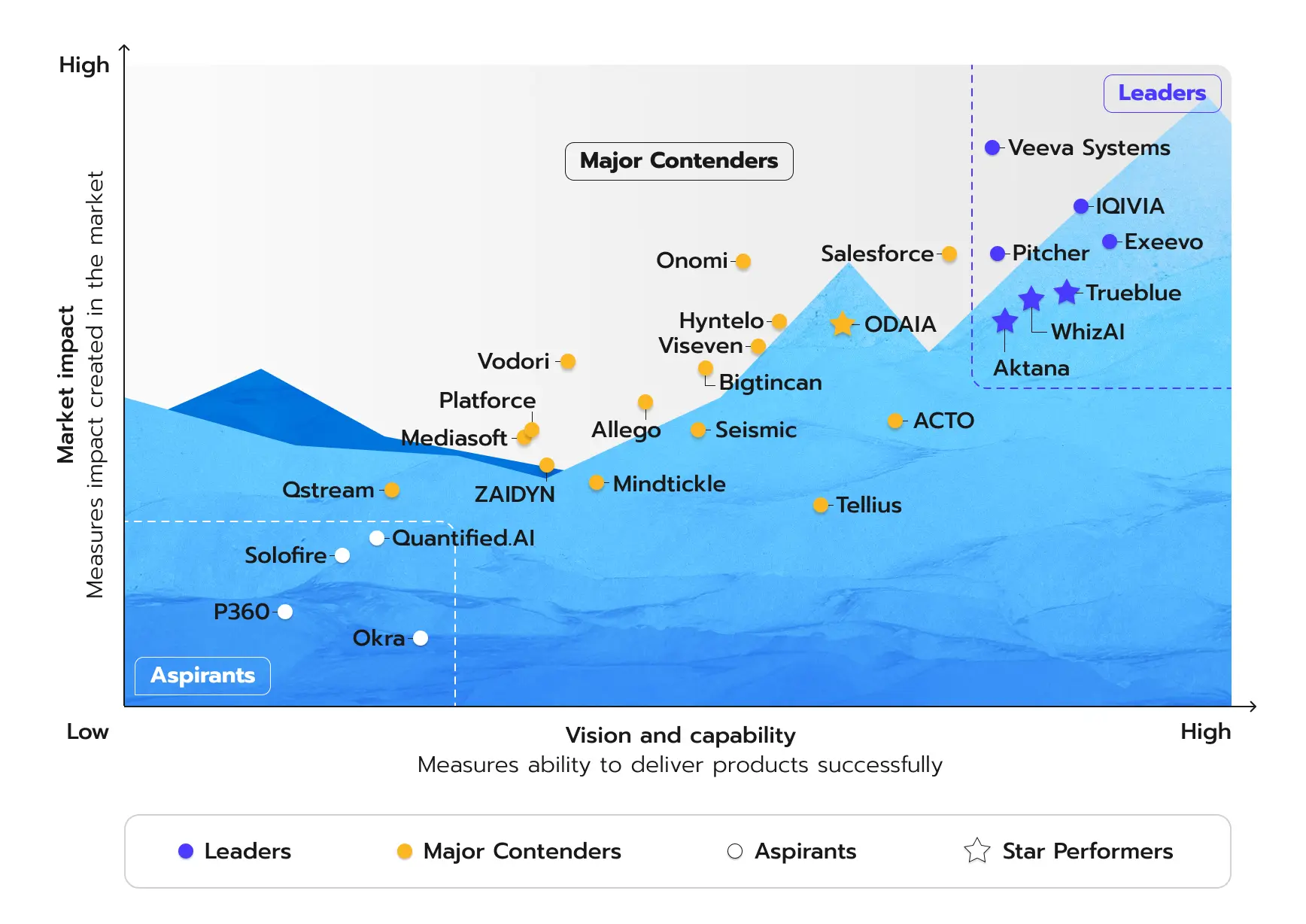Engaging new customers is an important undertaking, regardless of the industry. Eighty percent of customers believe that a company’s experience is just as important as its goods and services, according to the Salesforce State of the Connected Customer survey. Although the latest data suggests many people are fully satisfied with just getting a product that actually works, an increasing number of modern consumers seek emotional connections with brands. Businesses in the life sciences must successfully engage their clients to create unique experiences that propel business success.
In order to serve consumers and healthcare providers, hybrid commercial models require smooth, individualized interactions across channels. Advanced Customer Engagement Platforms (CEPs) offer omnichannel engagement, dynamic content management, and real-time data, surpassing the capabilities of classic CRM systems. These and other solutions contribute to successful customer engagement and help life sciences firms address customer needs more efficiently. As Jim Bush, Executive Vice President of World Service, wisely stated, “Getting service right is more than just a nice to do; it’s a must do.”
Understanding customer engagement in life sciences
First, let’s kick off with a definition. Customer engagement refers to providing clients with exceptional experiences throughout their entire journey. A strong customer engagement strategy is central to the overall customer experience. In the highly regulated field of life sciences, trust, compliance, and value are far more important than “relationships” in customer engagement. The primary customers in life sciences—medical institutions, patients, caregivers, and healthcare professionals (HCPs)—require specialized engagement strategies.
1. Healthcare professionals (HCPs). If you want to promote a medical product, service, or research, you must engage with doctors, nurses, or specialists. In an environment where HCPs anticipate evidence-based referral values for improved patient care and data for their medical decisions, the personal nature of contacts truly builds trust and education.
2. Patients and caregivers. Since patients are at the heart of healthcare delivery, they require engagement tactics focused on support, education, and accessibility. Caregivers have a significant impact on patient outcomes, particularly when it comes to chronic diseases, thus their role must be taken into account for effective involvement.
3. Clinics. Communication is more formal when interacting with clinics, hospitals, or research facilities; the engagement process is centered around collaboration, research projects, and the incorporation of new technology or treatment methods.
In life sciences, customer interaction extends beyond the promotion of products. It frequently entails the following:
– Education and assistance. Current, fact-based information about illnesses, treatments, and medical advancements.
– Customization. Tailored offers and communications according to information about different client segments.
– Omnichannel customer engagement. Ensuring smooth communication via social media, mobile apps, digital platforms, and in-person meetings while protecting patient privacy and legal requirements.

The evolution of customer engagement in life sciences
Over the years, customer engagement in the life sciences has transformed from transactional to more personalized, data-driven approaches. When the sector first began, communication with customers was restricted to personal interactions featuring product advertising. As the industry grew, CRM systems became prevalent in the 1990s, helping to manage healthcare professionals’ (HCPs’) interactions and laying the foundation for relationship-based engagement.
In the 2000s, CRMs reached a new level of sophistication with the integration of social media, mobile apps, and email. This led to omnichannel engagement, which includes in-person contacts between sales and the HCPs they are assigned to. These advancements enabled businesses to provide more specialized messaging and targeted information to patients and healthcare professionals. Most importantly, the data created by CRMs offered profound insights that helped improve customer engagement and sparked a game-changing shift in customer experience.
As consumer engagement tactics advanced, regulatory requirements became stricter, introducing new compliance challenges. Regulations like the General Data Protection Regulation (GDPR) and the Health Insurance Portability and Accountability Act (HIPAA) require life sciences businesses to process customer data responsibly and safely. Therefore, to comply with these criteria, the CRM systems used in the life sciences also had to be adapted, particularly regarding patient data and physician outreach.
The increased focus on data security and privacy has given CRMs the chance to advance and optimize the engagement process while adhering to strict legal standards. These days, sophisticated CRM systems offer audit trails, encryption, and safe data storage to safeguard sensitive data.
By satisfying an increasing need for more integrated, customized, and scalable customer engagements, Customer Engagement Platforms (CEPs) have advanced significantly in comparison to standard CRM systems. While CEPs have successfully connected sales and service to offer real-time omnichannel engagement and a much broader view of customer experience management, CRMs were mostly used as a tool for storing and organizing customer data to streamline sales and service activities.
The following are the primary differences between CEPs and CRMs:
- Omnichannel integrations. CEPs incorporate a variety of communication channels, including chatbots, mobile applications, social media, emails, websites, and in-person interactions, among others, to ensure that all data is in sync regarding the business’s customer engagement through any of these entry channels. These efforts help create an omnichannel customer strategy, helping organizations improve customer loyalty. Companies that use omnichannel methods keep 89% of their clients, compared to just 33% for those that don’t.
- Predictability of insights and real-time analysis. CEPs use AI and machine learning to analyze customer behavior in real time, allowing businesses to take the best possible actions. These actions include anticipating needs, tracking behaviors, and sending offers or personalized content.
- Personalized customer journeys. CEPs provide dynamic, context-aware consumer journeys by utilizing customer data to create highly customized experiences. This enables companies to interact with clients by presenting them with offers, communications, and material tailored to their tastes, habits, and past purchases.
- Automation workflows. CEPs make use of AI to automate repetitive processes and interactions. Conversational automation provides a smooth human touch, decreases manual labor, and improves customer satisfaction and process efficiency.
- Agentic AI. CEPs receive an advanced layer with agentic AI. The system acts autonomously to deconstruct complex tasks like HCP targeting, territory planning, and patient support. These intelligent agents go beyond traditional automation. They make real-time decisions, learn from data, and adapt fast.
- Sentiment and behavior analysis. CEPs use sentiment analysis and behavior tracking, providing a business with more customer insights like preferences and emotions. This information makes it possible to make better decisions and use proactive engagement tactics.
- 360-degree customer view. CEPs offer a cohesive picture of consumer interactions by extracting information from all touchpoints. This makes it possible for companies to provide a more responsive, individualized experience while guaranteeing uniformity in service and communication.
Key components of effective customer engagement
Providing the experiences and goods that customers want
Real-world evidence (RWE) obtained from post-marketing surveillance can be used by life sciences companies to improve their products and meet actual clinical demands. The most up-to-date research findings, legal compliance, and optimal patient care practices are guaranteed when key opinion leaders (KOLs) and medical advisory boards collaborate.
Ensuring a consistent brand’s voice
Having consistent brand messaging across all channels helps build trust with patients, doctors, and other stakeholders. It may be possible to verify the legitimacy and trustworthiness of brand communications by testing communication strategies against target audiences, such as patient advocacy or medical focus groups.
Prioritizing the onboarding of customers
Physician and patient adoption is facilitated by providing open, freely accessible information, such as websites with instructional resources, usage guidelines, and trial results. Setting up follow-up sessions via email or telemedicine guarantees that any early concerns are addressed, which promotes confidence in the good or service.
Creating positive incentives
Life sciences firms can encourage healthcare professionals to create a closer relationship with their brand by creating personalized loyalty programs or offering continuing medical education (CME) credits for extended involvement. Progress tracking and goal-setting tools give patients a sense of achievement and encourage ongoing engagement.
Contact centers for customer support
Advanced AI-driven triage solutions that assign medical science liaisons and expert staff to address in-depth questions enable a more effective and individualized support experience. It is also possible to track engagement history and follow-up activity by consolidating consumer interactions into a single platform.
Becoming a data-first organization
Accurate insight into customer behavior and treatment outcomes is developed by integrating data from clinical trials, CRM systems, and electronic health records (EHRs) into compliant analytics centers. Teams that receive data governance training are also more likely to make wise decisions and act proactively.
Targeted outsourcing
Businesses can outsource low-risk services like pharmacovigilance or patient support by collaborating with seasoned contract research organizations (CROs) and outside vendors with sound compliance frameworks. Well-defined KPIs help monitor service quality and regulatory compliance.

Why a fit-for-purpose customer engagement strategy matters in life sciences
Increasing customer retention rates by only 5% increases profits by 25% to 95%. This is why customer engagement strategies are no longer just a consideration—they’re non-negotiable requirements. Customer engagement, when done correctly, increases customer success metrics like customer satisfaction score (CSAT) and customer engagement metrics like conversion rates, net promoter score (NPS), and customer lifetime value (CLV). That being said, here is the list of more benefits of effective engagement:
Reason #1. Increased authenticity of the brand
Life sciences businesses are seen as trustworthy partners for improving healthcare when they interact with patients and healthcare professionals (HCPs) on a regular and transparent basis. Through the provision of accurate medical information, proactive assistance, and open communication, businesses may build trust, strengthen their brand image, and foster patient and clinical stakeholder loyalty.
Reason #2. Valuable real-world evidence (RWE)
In routine clinical practice, active consumers—whether HCPs or end users—provide insightful data on product performance. This data makes evidence-based marketing easier, streamlines trial designs, and supports product improvements. Companies have access to a wealth of RWE that helps them make better judgments and increase the clinical validity of their goods.
Reason #3. Quick product adoption
Effective customer interaction builds up the visibility of new therapies, allowing life sciences businesses to bridge the gap between regulatory approval and market uptake. Pre-emptive learning, extensive onboarding, and peer-to-peer endorsements can hasten uptake among HCPs and patients, ultimately driving adoption and establishing the therapy as a trusted solution.
Reason #4. Improved patient compliance
Strategic engagement goes beyond first-time prescribing to continued support throughout the treatment life cycle. With educational materials, digital solutions, and follow-up reminders, life sciences companies can overcome barriers to adherence, ensure proper use, and enhance treatment outcomes. Increased adherence also enables better real-world data and evidence of product benefit.
Reason #5. Collaborative opportunities with key opinion leaders (KOLs)
Partnerships with influential healthcare opinion leaders are essential to the development of new therapies, clinical guideline establishment, and best practice promotion. Early engagement with KOLs builds deep clinical insight and can speed the deployment of new medicines through healthcare systems, driving brand awareness and professional endorsement.
Reason #6. Increased competitive differentiation
Healthcare businesses that focus on meaningful engagement commit to improving customer service and provider experience—a unique competitive advantage in a saturated market. By repeated provision of relevant, evidence-based knowledge and personalized support, they stand out from the rest, build long-term relationships, and become go-to destinations for innovative healthcare solutions.
Best practices for engaging with healthcare professionals and patients
Effective engagement with healthcare professionals (HCPs) and patients in the life sciences industry is reliant on trust establishment, tailoring content to individuals, and ensuring seamless communication at every step of care. Customer Engagement Platforms (CEPs) achieve this by integrating data, analytics, and compliance functionality into one platform, allowing organizations to engage with all stakeholders in real-time, evidence-based dialogue.
A look at players in the market—Veeva, IQVIA, Exeevo, Pitcher, Trueblue, WhizAI, and Aktana—is a reflection of how advanced platforms can orchestrate omnichannel customer communications with regulatory-compliant supervision. These solutions integrate patient data, prescribing data, and engagement metrics, allowing them to tailor messages for specific HCPs or patient segments. By offering clinical support, education, and care management programs, life sciences companies can strengthen their role in healthcare and enhance customer trust.
Salesforce, a top enterprise software player, has also gained traction with life sciences. In addition to its very public CRM capabilities, Salesforce provides AI-driven insights, marketing automation, and real-time reporting tailored specifically for healthcare use. This enables companies to stay agile, streamline outreach, and react to evolving HCP and patient needs.
Notably, Salesforce is preparing to launch its Life Sciences Cloud for Customer Engagement. It is a specialized solution designed to unify data, personalize outreach, and accelerate engagement strategies. Salesforce will make it work across clinical, medical, and commercial functions. The platform marks a significant step forward in the way life sciences companies orchestrate omnichannel engagement while staying fully compliant.

Chart 1: Advanced Customer Engagement Platforms (CEPs) Market Leaders (2024)

Current studies project that 65% of healthcare consumers are more likely to be loyal customers if organizations engage them with purposeful, one-to-one communication during every stage of the customer journey. It speaks volumes for the success of effective customer engagement strategies in transforming single-purchase customers into lifetime brand champions. Through regular solicitations of customers’ feedback, life sciences companies can fine-tune everything from clinical trial designs to patient support materials, with the effect that their offerings remain meaningful and useful to their evolving set of customers.
To support high level of engagement, organizations need more than just good intentions. In most cases, they need the right tech stack. Avenga, as a technology enablement partner, help life sciences companies implement and scale CE strategizing with platforms and tools that are purpose-built for each unique industry.
Studies indicate that engaged customers are four times more likely to recommend a brand’s product or service, highlighting the long-term impact of strong relationships. When healthcare practitioners and patients are heard, supported, and empowered, they’re more apt to become ambassadors who endorse both the science and the experience of each product.
Ready to bring your customer engagement strategy to life? Avenga helps life sciences companies implement and scale engagement strategies to fit-for-purpose tech. From platform selection to integration and optimization, our experts make sure you can execute smarter, faster, and more compliantly across every touchpoint. Contact Avenga, your trusted customer engagement tech partner in life sciences.













